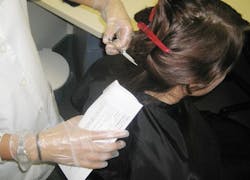Don’t brush off hair-testing
A three-day meeting held last week by a federal advisory panel on employee drug-testing indicates there’s at least some momentum building for the adoption of human hair as a testing specimen to screen job applicants and employees for the use of illegal drugs.
However, there’s a long bureaucratic route hair-testing must navigate before the Dept. of Transportation (DOT) will even consider proposing a rule requiring its use by motor carriers for drug-testing truck drivers.
That’s because “the DOT view is that it can only establish test procedures that mirror those [first] adopted by the Dept. of Health & Human Services (HHS) for use in the Federal Workplace Drug Testing Program,” Rob Abbott, vp of safety policy for the American Trucking Assns. (ATA), told FleetOwner.
“Once HHS adopts hair-testing,” he added, “it will wind up being adopted for rulemaking by other agencies, including DOT.”
The July 15-17 meeting in Rockville, MD, was called by the Drug Testing Advisory Board (DTAB) of HHS’ Substance Abuse & Mental Health Services Administration (SAMHSA) to update its process for “evaluating the scientific supportability of the hair specimen for federal workplace drug testing.”
The meeting notice also stated that DTAB would discuss everything from the “historical perspective of hair as a drug testing matrix” to experiences of best practices to hair drug-testing data.
Why is hair-testing even a regulatory topic? Proponents contend that unlike with drug-screening tests that use urine specimens, a hair sample can be collected much less “invasively” and can be attained almost anywhere. However, employers that use hair-testing of their own rarely use this method to test for alcohol use. That’s because that specific test is far more expensive than a urine-based one but doesn't yield useful information for most employers. What’s more, the federal government does not recognize hair-testing as valid to screen for alcohol use.
ATA’s Abbott advises that, convinced of its merits for detecting illegal drug use, a “number of carriers are already using hair-testing [as DOT does not prohibit i]. J.B. Hunt and Schneider National do so on a pre-employment basis as they’ve found that hair-testing is far more effective at identifying those applicants who are ‘lifestyle’ drug-users. “
But Abbott cautions that until hair-testing perhaps eventually becomes mandatory for truck drivers, carriers should bear in mind that “when a driver leaves employment and a potential new employer inquires past employers about drug-test results, the prior employer can only report what DOT-mandated testing indicated”— so any hair-testing results cannot be revealed.
According to Mogadore, OH-based Omega Laboratories, which provideshair- and oral-fluid testing for drugs of abuse to clients worldwide, at the meeting DTAB members heard from “highly recognized authorities in the drug-testing industry, including the laboratory directors from the three largest U.S.-based workplace hair-testing laboratories. Omega’s Dr. David Engelhart confirmed the scientific reproducibility of hair testing, stating that "proficiency testing has shown consistent results of the hair testing screening processes across multiple laboratories worldwide."
Omega reported that the public comments “mirrored those from other DTAB meetings over the last several years, which strongly favored the addition of hair as a specimen for testing.”
In particular, the firm related that “Five-years of dual-testing data from the trucking industry, which included over 200,000 DOT driver candidates from more than 25 different motor carriers, demonstrates that urine-testing by itself is no longer effective for pre-employment screening.”
Omega argued in a news release that “the fact that the three main workplace hair-testing laboratories have achieved equivalent levels of accreditation and participate in a robust international proficiency testing program should lead to swift and simple acceptance” of hair-testing for organizations that are required to perform Federal Workplace Drug Testing and have been limited to the use of urine specimens” since 1988.
“Many motor carriers have chosen to go above and beyond the federal requirements and have added hair-testing to ensure that they are screening out potentially dangerous employees,” noted Omega. “This comes at a cost, as these companies are still required to pay for the currently mandated urine testing as well.
“Hair-specimen testing provides a significantly longer detection window, is very difficult to adulterate, and eliminates collection issues associated with urine,” the company continued. “As a result, hair-testing has consistently identified over three times as many illegal substance users as urine-testing in regulated industry pre-employment trial programs. Regulated industries in other countries, including airlines and government agencies, have already had improved success with both hair and laboratory-based oral fluid testing.”
"We feel that the acceptance of both hair and laboratory-based oral fluid testing by SAMHSA will be a key factor in maintaining the United States drug testing program's position as the true 'gold standard,'" states Bill Corl, Omega’s CEO.
The upshot is the evidence is growing that hair-testing should become the new standard for drug-screening employees. But before DOT will even contemplate mandating it for trucking, HHS must start its own rulemaking process to bring it to life.
